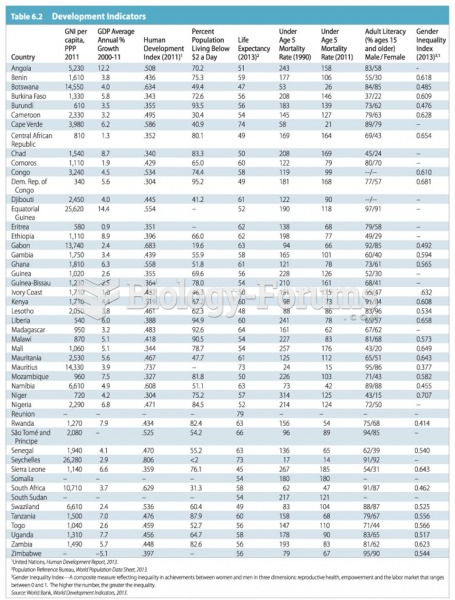Answer to Question 1
Answer: In computing the Human Development Index (a measure of a country's level of development), the United Nations considers three components. These are wealth, education and good health. This is because it is believed that good health is a very important measure of a country's development. A goal of development, therefore, must include the provision of adequate nutrition and medical services needed for people to lead long and healthy lives.
In calculating the health component of the HDI, the UN uses life expectancy at birth. A baby born today in a developed region is on average expected to live ten years longer than one born in a developing region. It should be noted that there is a wide variation among developing regions. Life expectancy in East Asia and Latin America is comparable to developed regions . but in Sub-Sahara Africa, it is only in the low fifties.
People generally live longer and are healthier in developed countries than in developing ones because of better access to health care. For example, 17 percent of children in developing countries are not immunized against measles, compared to 7 percent in developed ones. More than a quarter of children lack measles immunization in South Asia and Sub-Saharan Africa. The gap between developed and developing countries is especially high in expenditures on health care. Developed countries spend more than 4,000 per person annually on health care, compared to approximately 200 per person in developing countries. Total expenditures on health care exceed 7 percent of GNI in developed countries, compared to 2 percent in developing ones. If developing countries are to make real progress tin development, then access to health needs to be
Answer to Question 2
Answer: The United Nations has found that there is gender inequality in every single country in the world. In every country, women are not treated as well as men. Whereas some countries have made progress in addressing equality, at best women have achieved near-equality with men in some countries, whereas in other countries the level of development of women lags far behind the level for men.
To measure the extent of each country's gender inequality, the United Nations has created the Gender Inequality Index (GII). The GII measures inequality between men and women. The higher the score the greater is the inequality between men and women. As with the other indices, the GII combines multiple measures, in this case reproductive health, empowerment, and labor.
For the empowerment component, the GII measures two indicators. The first is the percentage of seats held by women in the national legislature. The second is the percentage of women who have completed high school. In both of these measures, developed countries do better than in developing regions.
For the reproductive health measure, the GII examines two indicators. these are maternal mortality ratio and adolescent fertility rates. Maternal mortality ratio is the number of women who die giving birth per 100,000 births. Adolescent fertility rate, on the other hand, is the number of births per 1,000 women age 15-19. In both of these measures, the figures are generally worse in developing countries except in East Asia, where the GII is comparable to that of developed regions.
The third component of the GII is the labor force participation rate. This is the percent of women holding full-time jobs outside the home. Women in developing countries are less likely than women in developed countries to hold full-time jobs outside the home.
Generally, the GII is better in developed countries than in developing countries, except in East Asia, where the GII is comparable to that of developed regions. Compared to other developing countries, China has high female education levels and participation in the labor force and low maternal mortality and teenage fertility rates.







